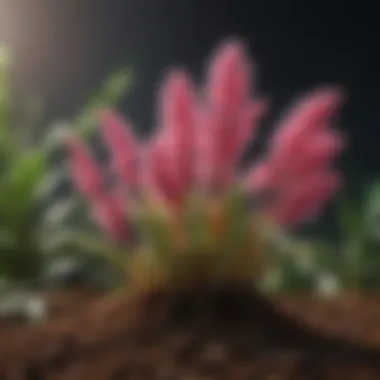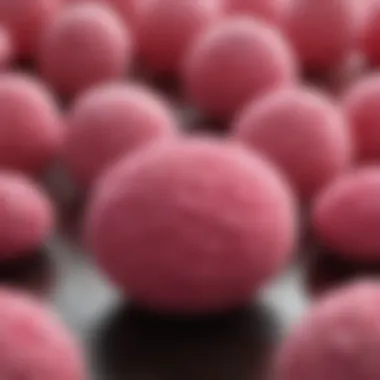Comprehensive Guide to Pink Stuff for Hair: Applications in Agriculture and Agronomy


Topic Overview
Definition and Importance
The term "pink stuff" refers to a specific product that is known for its unique chemical composition and varied applications, especially within agriculture and agronomy. This product has gained traction due to its potential to enhance plant growth and support sustainable farming practices. Understanding the fundamental qualities of this substance is essential for stakeholders in the agricultural sector. Its relevance lies not only in the improvement of crop yields but also in promoting environmental health.
Brief History and Evolution
The origins of pink stuff can be traced back to traditional practices where various natural compounds were used for plant care. Over time, as agricultural science evolved, the formulation of such products became more sophisticated. Advances in chemistry allowed the development of a reliable product that combines effective elements for both plant and hair care. The journey from rudimentary mixtures to contemporary formulations illustrates the growing recognition of the importance of sustainable practices in agriculture. This evolution has opened new avenues for research and application.
Key Techniques and Innovations
Sustainable Farming Practices
In recent years, sustainable farming practices have become paramount in agriculture. The application of pink stuff fits into this category by promoting efficient resource use while minimizing environmental impact. For example, farmers can integrate pink stuff into their routines to enhance soil health and reduce the need for synthetic fertilizers. This practice aligns with the growing demand for organic produce and sustainable methods.
Advanced Agronomic Technologies
The use of pink stuff is supported by various agronomic technologies that facilitate its application. Technologies like precision agriculture leverage data analytics to optimize input use and maximize output. These innovations ensure that products like pink stuff are used in a targeted manner, enhancing their effectiveness while reducing waste. By adopting advanced technologies, farmers can better manage resources, resulting in improved environmental outcomes.
Practical Applications
Step-by-Step Guides
Implementing pink stuff in agricultural practices involves a few systematic steps:
- Assessment: Evaluate soil health and crop needs.
- Formulation Selection: Choose the appropriate pink stuff formulation for the specific crop.
- Application Timing: Apply during optimal growth stages for maximum benefit.
- Monitoring: Regularly assess the impact on plant health and adjust usage as needed.
This methodical approach ensures that the application of pink stuff is efficient and effective.
Case Studies or Real-World Examples
Several farmers have reported improvements in yield quality and quantity after using pink stuff. One case in a small organic farm in California demonstrated a noticeable increase in plant growth rate and soil fertility within a few weeks of application. Such empirical evidence underlines the significance of understanding its applications and benefits thoroughly.
"The integration of pink stuff into our farming practices has not just enhanced our crop yields but also made us more aware of our environmental footprint." - A local farmer's testimony.
Through these steps and examples, it becomes clear that pink stuff offers valuable contributions to sustainable agriculture and agronomy. Each application resonates back into broader themes of health, growth, and sustainability, making it a topic worthy of exploration.
Understanding Pink Stuff
As one explores the intersection of agriculture and hair care, the topic of pink stuff emerges as both intriguing and multifaceted. This substance has gained attention not only for its aesthetic applications but also for its underlying potential benefits in agricultural practices. It is crucial to examine the importance of pink stuff within this article, as it represents a unique convergence of sectors typically considered distinct yet interconnected through biological and chemical principles. Understanding its properties and potential uses fosters a deeper appreciation for innovation and sustainability in both hair care and agriculture.
Definition and Overview
Pink stuff refers to a variety of hair care products characterized by their distinctive hue, texture, and chemical composition. These formulations are rich in nutrients, moisturizing agents, and sometimes, bioactive compounds aimed at promoting hair health. The term "pink stuff" may encompass several products, including shampoos, conditioners, and treatment masks, particularly those geared towards enhancing moisture retention and overall hair vitality.
The appeal of pink stuff lies in its versatility. In hair care, users often report improved hydration and manageability. In agriculture, such products are being repurposed to assess their contributions to plant growth and health. The chemical composition, while primarily intended for hair, can provide nutrients that benefit soil health and plant resilience. Thus, a detailed understanding is essential for any practitioner or enthusiast looking to innovate in either field.
Historical Context
The emergence of pink stuff in modern hair care can be traced back several decades, with origins in early formulations aimed at combatting dry and damaged hair. Initially, these products were developed mainly for cosmetic purposes, catering to a growing consumer base that prioritized hair appearance. Over time, as scientific research unveiled the potential benefits of certain ingredients, formulators began to incorporate more complex compounds targeting not just cosmetic appeal but also hair health.
The agricultural applications of similar formulations have seen a notably different trajectory. Historically, the idea of employing cosmetic products in agriculture faced skepticism. However, shifting perspectives regarding sustainability and resource utilization have catalyzed interest in unconventional uses of everyday items, including those found in personal care. Today, the dialogue around pink stuff in both realms underscores a significant evolution, reflecting an understanding that health—whether human or plant—can be supported through innovative and responsible practices.


In sum, understanding the definition and historical context of pink stuff is pivotal for appreciating its relevance and applications in agriculture and agronomy. As we continue to explore the chemical composition and practical applications, a thorough grasp of its background enhances the potential for synergistic uses in both fields.
Chemical Composition
Understanding the chemical composition of pink stuff is vital to fully grasp its relevance in both hair care and agriculture. Each component plays a unique and significant role in its effectiveness. Analyzing the ingredients allows us to appreciate the functionality and benefits of this product in different applications.
Primary Ingredients
The primary ingredients of pink stuff vary from formula to formula. Typically, one can find components such as:
- Sodium Bicarbonate: This ingredient is known for its mild abrasiveness, making it useful for eliminating build-up in both hair care and plant systems.
- Citric Acid: This naturally-sourced acid helps in adjusting pH levels, promoting healthier hair and benefiting plant hydration processes.
- Coconut Oil: Renowned for its emollient properties, coconut oil adds shine to hair while acting as a natural pesticide when used in horticulture.
- Essential Oils: Often included for their aromatic properties, they can also offer antifungal and antibacterial benefits, helping to protect both hair and plants against diseases.
Each of these ingredients contributes unique properties that enhance the overall performance of pink stuff.
Role of Each Component
Breaking down the role of each component illuminates their individual contributions to the efficacy of pink stuff.
- Sodium Bicarbonate
- Citric Acid
- Coconut Oil
- Essential Oils
- Acts as a gentle exfoliant, which cleanses the scalp and plant leaves without harsh damage.
- Enhances the absorption of nutrients in both hair follicles and soil as it interacts with organic materials.
- Balances the pH, crucial for maintaining healthy scalp conditions and optimizing root growth in plants.
- Aids in breaking down mineral deposits, thus improving nutrient bioavailability in agricultural practices.
- Strengthens hair by penetrating the hair shaft, helping to reduce breakage.
- Functions as a natural barrier against pests in agriculture, contributing to healthier plant development.
- Provide antimicrobial benefits that help in conditioning hair and keeping plants free from pathogens.
- Their strong scents deter pests, enhancing plant health naturally.
In summary, a comprehensive understanding of the chemical composition allows users to utilize pink stuff effectively in both hair and agricultural applications. Each ingredient serves a distinct purpose that enhances the overall health of hair and plants, emphasizing the interconnectedness of these uses.
"The effectiveness of any product lies in its ingredients. Understanding these can lead to better outcomes in both beauty and agriculture."
Through this analysis, readers can see how the formulation of pink stuff matters. The synergy of these ingredients contributes to its effectiveness, making it an important solution for those in the fields of hair care and agriculture.
Application in Hair Care
The use of 'pink stuff' in hair care holds significant value, especially when considering its multifaceted benefits. This section delves into how this product impacts hair health as well as its various applications. Understanding its properties can enhance its integration into both personal grooming and agricultural practices. The insights provided here aim to equip enhtusiasts with the knowledge necessary to maximize the efficacy of 'pink stuff' in their hair care routines.
Benefits for Hair Health
Pink stuff contains several active components beneficial for hair. These ingredients work in synergy to address common hair issues such as dryness, brittleness, and lack of shine. Some of the key benefits include:
- Moisturization: The product helps to hydrate strands, making hair softer and more manageable. This is essential for individuals with dry or coarse hair textures.
- Strengthening: It reinforces hair structure by reducing breakage, which is crucial for maintaining length and overall health. Regular use can lead to visibly stronger hair.
- Shine Enhancement: Another notable effect is the improvement in luster. Users often report shinier hair after incorporating the product into their routine, which can be especially appealing.
- Scalp Health: Healthy hair starts with a healthy scalp. The product assists in maintaining scalp hygiene, alleviating issues like dandruff or irritation, which promotes a better environment for hair growth.
"Incorporating pink stuff into hair care rituals can elevate the overall condition of hair, paving the way for better growth and aesthetics."
Common Use Cases
The versatility of pink stuff allows for various applications tailored to the specific needs of an individual's hair. Here are some common use cases:
- Deep Conditioning Treatment: Users often apply it as a deep conditioner after shampooing, allowing the product to sit for a longer duration to penetrate the hair effectively.
- Leave-In Conditioner: Applied to damp hair post-wash, it functions as a leave-in treatment, ensuring ongoing moisture throughout the day.
- Scalp Treatment: For those with sensitive scalps, it can be massaged directly onto the scalp to soothe and nourish, thereby promoting healthier hair growth.
- Pre-Styling Protection: Before heat styling, pink stuff serves as a protective barrier. This helps to prevent damage from styling tools, reducing the risk of heat-related hair issues.
In sum, integrating pink stuff into hair care regimens presents numerous advantages, from enhanced health to improved aesthetics. By understanding its benefits and various uses, individuals can better tailor their hair care approaches to achieve desired results.


Use in Agriculture
The use of pink stuff in agriculture is a topic of growing interest due to its diverse application potential. This product is not only beneficial for hair but has also exhibited significant advantages for agricultural practices. Its integration into plant care routines can promote healthier growth, improve soil quality, and maximize resource efficiency. Understanding its specific benefits helps farmers make informed choices.
Influence on Plant Growth
The role of pink stuff in plant growth is crucial. This substance provides essential nutrients that help in the development of robust plants. It enhances growth rates and helps fight off common agricultural pests and diseases. Some specific ways it influences plant growth include:
- Nutrient Enrichment: The components of pink stuff can supply vital nutrients essential for plant vitality. This can include nitrogen, phosphorus, and potassium, which are critical for plant metabolism.
- Soil Improvement: When applied, it can enhance the texture and structure of the soil, leading to better aeration and water retention. This, in turn, facilitates optimal root growth and development.
- Stimulating Microbial Activity: The addition of pink stuff can promote beneficial microbial activity in the soil. Healthy microbial communities are important for nutrient cycling and soil fertility.
"Using pink stuff in agriculture can lead to healthier harvests and improved plant resilience."
Integrating Hair Care Products in Horticulture
Integrating hair care products, particularly pink stuff, into horticulture requires a nuanced approach. This may seem unconventional, yet it presents considerable advantages. Farms and gardeners can benefit from the reuse and repurposing of hair care substances, provided they align well with plant health. Key considerations include:
- Compatibility with Plant Needs: It's important to ensure that the ingredients in hair care formulations do not contain harmful substances for plants. Researching ingredient safety can prevent adverse effects.
- Resource Efficiency: The incorporation of pink stuff can promote sustainability. Farmers can reduce waste by using hair care products that would otherwise be discarded. This lowers overall costs while benefiting crops.
- Application Methods: Different application methods may need to be considered. For example, mixing the product with water for a foliar spray can enhance nutrient absorption by plants.
The unique attributes of pink stuff position it as an innovative component in horticultural practices, potentially opening new avenues for sustainable agriculture.
Sustainability Considerations
Sustainability considerations in the use of 'pink stuff' for hair, particularly in the contexts of agriculture and agronomy, are crucial. As environmental awareness grows, it is imperative to evaluate the impact that products have on our ecosystems. By understanding sustainability, we can better assess how the application of pink stuff can align with eco-friendly practices.
Effective sustainability strategies benefit both the environment and agricultural productivity. The importance lies not only in the product's performance but also in its life cycle. Each stage, from production to application, offers opportunities for reducing negative impacts. Evaluating the entire process helps identify key areas where improvement can be made.
Environmental Impact Assessments
Environmental impact assessments (EIAs) provide a framework for analyzing the consequences of using pink stuff in hair care and agricultural settings. These assessments consider various factors, such as:
- Resource Consumption: Understanding how much water and energy are required for the production of pink stuff.
- Chemical Runoff: Analyzing potential runoff into soil and water systems post-application, which can affect local biodiversity and water quality.
- Waste Management: Evaluating how the packaging and residual product are managed after use.
- Biodiversity Effects: Identifying how pink stuff interacts with local flora and fauna.
Conducting EIAs regularly can guide stakeholders in making more informed decisions and adjusting practices to minimize harm. Furthermore, they serve as a basis for regulatory compliance, as many jurisdictions require such assessments for new products.
Eco-Friendly Alternatives
As the demand for sustainable products rises, exploring eco-friendly alternatives to traditional pink stuff becomes essential. These alternatives can provide similar benefits while minimizing environmental footprints. Some notable eco-friendly options include:
- Plant-Based Ingredients: Natural compounds derived from plants can often replace synthetic additives, thus reducing risks associated with chemical exposure.
- Biodegradable Packaging: Utilizing materials that break down more easily helps reduce long-term waste in landfills and oceans.
- Organic Formulations: Products that utilize ingredients grown without synthetic pesticides or fertilizers can contribute to healthier ecosystems.
- Local Sourcing: Supporting local suppliers reduces transportation emissions and fosters community engagement.
Safety and Regulations
In the context of using pink stuff for hair, the discussion around safety and regulations is crucial. This section seeks to unfold the various implications of applying these products, particularly in agriculture, to ensure that consumers and farmers alike are informed about associated risks, as well as legal compliance. Regulatory standards not only help safeguard users from potential hazards but also serve to maintain the integrity of agricultural practices.
Health Risks Associated with Use
Utilizing pink stuff for either hair care or agricultural applications can lead to some health risks. While many products are designed with safety in mind, it is important to understand the components within these formulations. Some users have reported skin irritations, allergic reactions, or respiratory problems after exposure.
- Chemical Sensitivity: Some individuals may have a sensitivity to specific chemicals found in these products. Even if these substances are generally considered safe, personal reactions can vary widely.
- Environmental Toxins: There may be concerns regarding how these chemicals affect the surrounding ecosystem, especially when these products are utilized in outdoor settings.
- Long-Term Effects: The long-term exposure to certain ingredients may contribute to chronic health conditions. Understanding these risks is essential for safe use.
"Regulatory measures are not just about compliance; they are about protecting human health and the environment."
Compliance with Regulatory Standards


Most countries have established regulatory frameworks that govern the use of personal care products and agricultural inputs. These standards serve to guide the manufacturing, distribution, and application of products like pink stuff.
- Material Safety Data Sheets (MSDS): These documents are vital for all chemicals. They provide important handling and safety information, ensuring responsible use.
- Registration and Labeling: Regulatory bodies often require that products be accurately labeled to inform users about proper application, potential risks, and safety precautions.
- Periodic Reviews: Regulations evolve, which means that continual review of safety data and compliance checks are necessary to ensure that the products remain safe over time.
Case Studies and Empirical Evidence
Understanding the impact of 'pink stuff' through real-life experiences and empirical research is crucial. This section presents insights derived from various case studies, which highlight both its applications in agriculture and user experiences in hair care. These case studies not only offer tangible evidence of the product's effectiveness but also provide relatable narratives for both farmers and hair care enthusiasts. The details gathered from these studies will deepen comprehension of the advantages and limitations associated with the use of 'pink stuff'.
Field Trials in Agriculture
Field trials are essential to assessing the impact of 'pink stuff' in an agricultural setting. Numerous studies have been conducted to evaluate its effects on plant growth and overall crop performance. These trials often measure variables such as yield, plant height, and disease resistance. In one notable case, a trial in a soybean field demonstrated a significant increase in yield when 'pink stuff' was applied alongside standard fertilizers. The study highlighted how the unique formula in 'pink stuff' improved nutrient absorption, leading to healthier plants.
Additionally, another field trial focused on tomato crops. Farmers noted that applying 'pink stuff' resulted in stronger stems and less susceptibility to pests. The empirical data collected from these trials reveals the potential benefits of integrating hair care products into agricultural practices.
User Experience in Hair Care
The experiences of users who incorporate 'pink stuff' into their hair care routine provide valuable perspective. A survey conducted among various beauty enthusiasts showed that many prefer 'pink stuff' for its restorative properties. Users reported improvements in hair texture and overall health, citing reduced breakage and enhanced shine.
Common feedback indicated that utilizing 'pink stuff' alongside regular hair shampoos produced noticeable benefits. Many highlighted that their hair felt softer and more manageable after use. This anecdotal evidence complements formal studies, underscoring its viability in hair treatment.
In summary, the case studies and empirical evidence illustrate the versatility of 'pink stuff'. They provide a compelling argument for its application in both agriculture and personal hair care practices, showcasing its effectiveness in enhancing growth, health, and aesthetic appeal.
Future Directions
The exploration of pink stuff for hair opens a myriad of possibilities for future advancements in both hair care and agricultural practices. Understanding these future directions is crucial for further innovation. As this industry evolves, there are various factors that will influence its trajectory, particularly the integration of technology and research in refining formulations. Both consumers and professionals in agriculture and hair care sectors stand to benefit substantially from such developments.
Innovations in Hair Care Formulations
Innovative approaches in hair care formulations are indeed on the rise. Manufacturers are increasingly focusing on natural ingredients and sustainable practices. This shift aligns with consumer demand for products that are both effective and environmentally friendly. Recent trends point towards the use of bioactive compounds derived from plants, which can enhance the efficacy of pink stuff.
Some specific innovations include:
- Improved Textures: Formulators are working on achieving a smoother application and less greasiness in products, making them more user-friendly.
- Increased Longevity: Development of long-lasting effects promotes improved health for hair through consistent use, benefiting those in agriculture by reducing the need for frequent reapplications.
- Synergistic Blends: Combining pink stuff with other hair care ingredients can create multi-functional products that target diverse hair concerns, thereby expanding its market.
The emphasis on consumer education is also growing, guiding users on how to choose the right formulations based on hair types and specific needs. This aspect is essential for future growth.
Potential in Agricultural Practices
The potential of pink stuff in agricultural practices is noteworthy. As farmers seek unconventional methods to enhance productivity, integrating such products could lead to notable improvements in plant health and yield. Researchers continue to investigate optimal usage scenarios, including:
- Soil Enrichment: Incorporation of pink stuff into soil could positively affect nutrient availability, promoting healthier plant growth.
- Natural Pest Resistance: By leveraging the natural properties of hair care formulations, farmers might discover effective pest repellent functions, reducing the need for chemical pesticides.
- Plant Stress Mitigation: Understanding how this substance interacts with plants under stress could result in better resilience strategies for crops.
"Pioneering research in formulation and application will determine the efficacy of pink stuff across diverse uses in agriculture and hair care."
The focus should remain on fostering collaboration between chemists, agronomists, and hair care specialists to fully harness its potential.
End
In this article, we explored the multi-faceted applications of 'pink stuff' in both hair care and agricultural practices. This product serves as a bridge between personal grooming and plant health, demonstrating its versatile advantages across varied fields. The integration of such products can lead to improved outcomes in hair vitality while also addressing growth challenges in crops.
Summation of Key Points
- Chemical Composition: The specific components of pink stuff underline its effectiveness. With primary ingredients working in tandem, users benefit from enhanced hair health and plants experience better growth rates.
- Application Scope: The versatility of pink stuff allows it to be effectively integrated into hair care routines and agricultural practices, making it relevant for a broad audience.
- Sustainability: The environmental assessment shows that when used judiciously, pink stuff promotes sustainability within both hair care and farming practices, stressing the importance of eco-friendly usage.
- Safety Measures: The health risks and regulatory standards provide essential guidelines for safe use, ensuring that users can reap the benefits without compromising safety.
- Call for Empirical Evidence: Case studies demonstrate both user experiences and agricultural outcomes, which highlight the real-world effectiveness of the product.
Call for Further Research
As promising as the data may seem, there remains a pressing need for further investigation. Several areas deserve attention:
- Long-term Effects: Future studies should focus on the sustained impact of pink stuff in both agriculture and personal care over extended periods.
- Detailed Ingredient Studies: Individual component studies will provide a deeper understanding of their specific roles and interactions, leading to more tailored applications.
- Wider Scope of Use Cases: Exploring alternative uses of pink stuff, beyond the current applications, could unveil new benefits that align with evolving agricultural practices and hair care needs.



